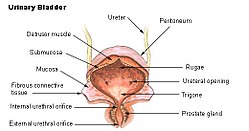| This article needs additional citations for verification. Please help improve this article by adding citations to reliable sources. Unsourced material may be challenged and removed. Find sources: "Trigone of the urinary bladder" – news · newspapers · books · scholar · JSTOR (November 2016) (Learn how and when to remove this message) |
| Trigone of urinary bladder | |
|---|---|
 Urinary bladder Urinary bladder | |
 The interior of bladder. The interior of bladder. | |
| Details | |
| Identifiers | |
| Latin | trigonum vesicae urinariae |
| TA98 | A08.3.01.024 |
| TA2 | 3421 |
| FMA | 15910 |
| Anatomical terminology[edit on Wikidata] | |
The trigone (also known as the vesical trigone) is a smooth triangular region of the internal urinary bladder formed by the two ureteric orifices and the internal urethral orifice.
The area is very sensitive to expansion and once stretched to a certain degree, stretch receptors in the urinary bladder signal the brain of its need to empty. The signals become stronger as the bladder continues to fill.
Embryologically, the trigone of the bladder is derived from the caudal end of mesonephric ducts, which is of mesodermal origin (the rest of the bladder is endodermal). In the female the mesonephric ducts regress, causing the trigone to be less prominent, but still present.
Clinical significance
The region can be infected causing trigonitis to persist.
References
- Woodburne, Russell T. (1965-03-01). "The Ureter, ureterovesical junction, and vesical trigone" (PDF). The Anatomical Record. 151 (3): 243–249. doi:10.1002/ar.1091510305. hdl:2027.42/49801. ISSN 1097-0185. PMID 14324081.
External links
- Anatomy photo:44:04-0203 at the SUNY Downstate Medical Center - "The Male Pelvis: The Urinary Bladder"
| Anatomy of the urinary system | |||||||||||||
|---|---|---|---|---|---|---|---|---|---|---|---|---|---|
| Kidneys |
| ||||||||||||
| Ureters | |||||||||||||
| Bladder |
| ||||||||||||
| Urethra | |||||||||||||